In this article:
Hair is an important aspect of one’s appearance and needs to be properly taken care of. Children and teenagers are often self-conscious of their appearance among peers, and hair loss during childhood can be a very distressing condition for them.
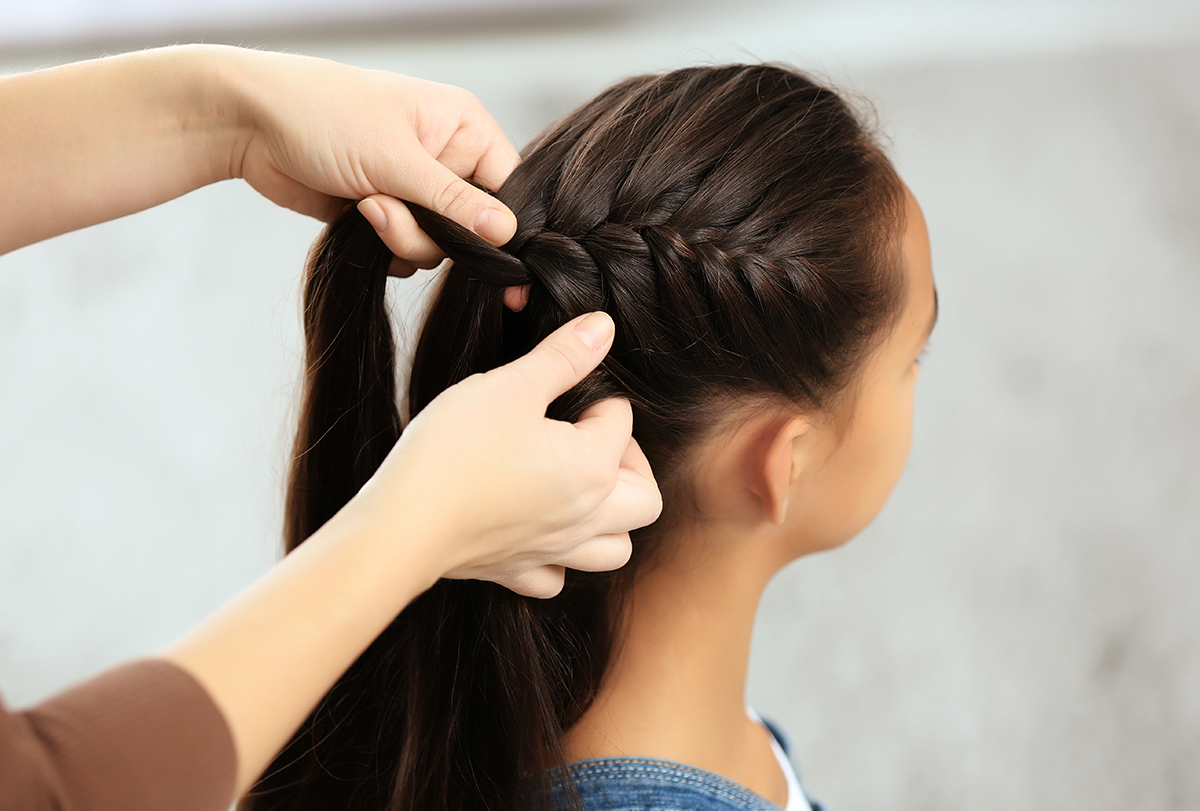
Take a look at some common causes of hair loss in children and how to treat it. (1)
Causes of Hair Loss in Children
Hair loss can be due to these factors.
1. Poor nutrition
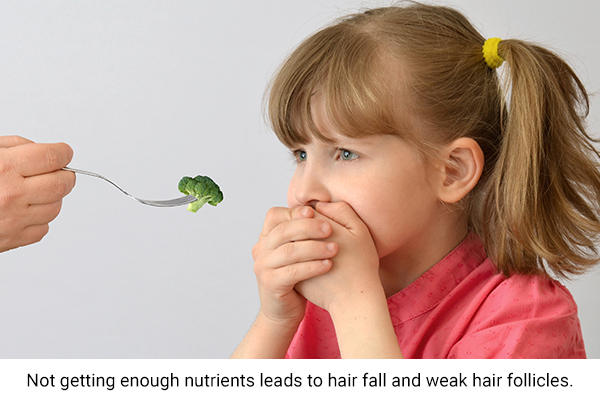
Just like a child’s body, their hair also needs proper nutrients to grow. Protein, vitamin C, zinc, iron, etc., are some essential nutrients required for hair growth. Not getting enough of these nutrients will lead to hair fall and weak hair follicles. (2)
2. Alopecia areata
Alopecia areata is technically an immune disorder that leads to hair loss. It occurs when the immune system attacks the hair follicles by mistaking them to be foreign substances. This can cause bald patches on the scalp. (3)(4)
3. Telogen effluvium
Telogen effluvium is usually triggered by stress or illness. It can lead to nonscarring alopecia by causing more hair to be in the telogen phase, or shedding phase, of the hair growth cycle. (1)
4. Tinea capitis
Tinea capitis is a fungal infection that can affect the scalp. It is commonly seen in children and leads to hair loss.
5. Anagen effluvium
Anagen effluvium is a form of rapid hair loss that is also seen often in children. It can be triggered by certain medications. (5)
Treatment for Hair Loss in Children
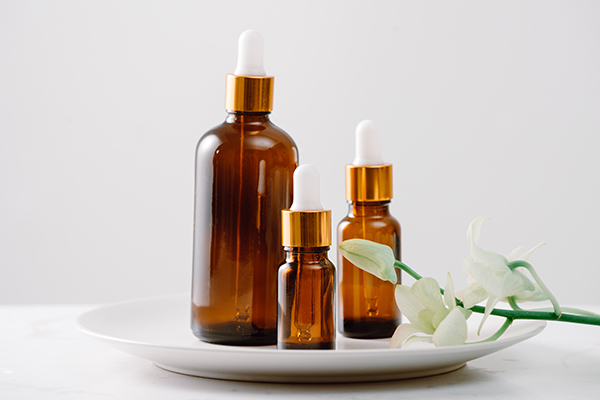
Here are some common medicines dermatologists prescribe for hair loss:
1. Topical treatments
- Topical minoxidil – Topical minoxidil helps reduce hair loss triggered by hormonal causes. Low doses may be used in children who suffer from alopecia. (6)(7)
- Topical corticosteroids – Topical corticosteroids are usually the most common medications given by dermatologists to combat childhood alopecia. (8) They promote hair regrowth and usually do not have harsh side effects at low doses.
- Anthralin – Anthralin is a topical treatment that can be useful for people suffering from scalp psoriasis. Use it as recommended by your doctor. (4)
2. Oral treatments
At times, oral corticosteroids can be prescribed to children who suffer from severe alopecia or hair loss.
Home Remedies for Hair Growth in Children
Many forms of hair loss caused by nutritional deficiencies or improper hair care can be cured by some natural remedies. It may be beneficial to try a few home remedies for hair growth before taking medication. These natural remedies can also be used alongside medical treatment for healthier hair.
Here are the most popular and effective hair growth remedies you can use for your child:
1. Massage with oil
Coconut oil, almond oil, and olive oil have traditionally been used to condition and nourish hair in many cultures. These oils are rich in antioxidants and beneficial nutrients for the hair follicles. They also help in keeping the hair hydrated, reducing frizz and hair damage. (9)
How to use:
- Apply virgin coconut oil or olive oil to your scalp and hair.
- Massage the hair for a couple of minutes.
- Let the oil absorb for half an hour to one hour before washing it off.
2. Apply an aloe vera mask
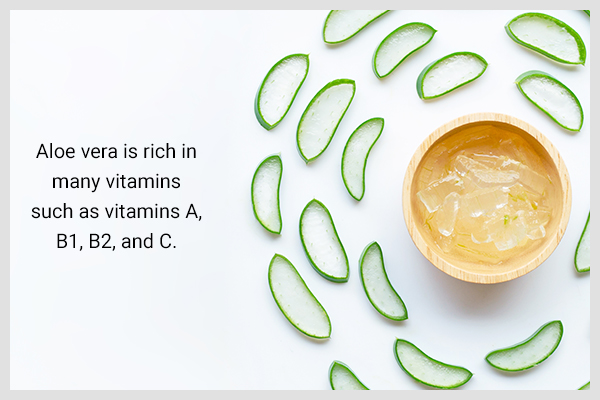
Aloe vera has various antioxidant, anti-inflammatory, and antimicrobial properties. (10)
It is rich in many vitamins such as vitamins A, B1, B2, and C. It also contains trace amounts of folic acid. All of these play vital roles in nourishing the hair follicles and promoting hair growth. (11)
How to use:
- Scoop fresh aloe vera gel from aloe vera leaves.
- Apply the gel to your scalp and hair.
- Let it sit for half an hour before washing it off.
3. Rinse with rice water
Rice water is rich in amino acids. It can help make your hair thicker and shinier by increasing the protein content of your hair.
How to use:
- Soak some washed rice in water for 30–60 minutes.
- Strain this cloudy water and store it in a jar. It will keep for 2–3 days.
- Use this rice water to rinse your hair after shampooing. Let it seep into your scalp and hair for 5–10 minutes.
- Wash it off with normal water. (12)
4. Apply hibiscus oil
Hibiscus flowers contain amino acids, which are the building blocks of protein and can give you strong and thick hair. Hibiscus flowers also contain vitamin C, which is a well-known antioxidant.
How to use:
- Make a hibiscus and coconut oil concoction by boiling some ground hibiscus petals in the oil for 3–4 minutes.
- After cooling, store this oil in a mason jar.
- Apply it to your scalp and hair half an hour before a shower. (13)
5. Apply a fenugreek seed mask
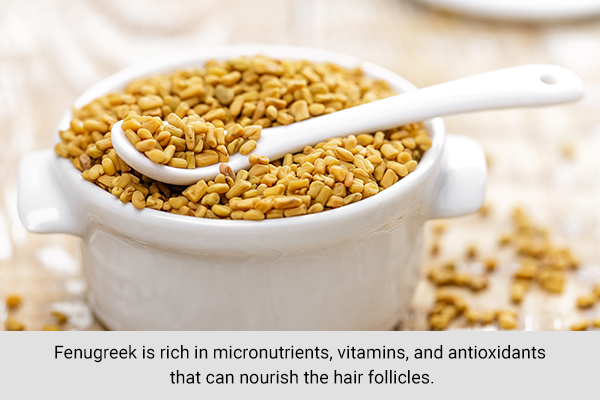
Fenugreek is useful for hair growth in more ways than one. It is rich in micronutrients, vitamins, and antioxidants that can nourish the hair follicles.
Fenugreek also contains saponins, which are plant compounds that may interfere with DHT (dihydrotestosterone) metabolism. DHT is a major hormonal trigger for alopecia. (14)
How to use:
- Make a fenugreek paste by soaking some fenugreek seeds in water.
- Grind them to make a paste.
- Apply this paste directly to your scalp, and cover your hair with a shower cap or towel.
- Let it sit for half an hour before washing it off.
6. Try lavender oil
Lavender oil is filled with antioxidants and anti-inflammatory agents that can soothe the scalp and promote hair growth.
It is rich in phytochemicals such as linalool and geraniol. These phytochemicals can promote hair growth by reducing dandruff and stimulating the hair follicles. (15)
How to use:
- Mix a few drops of lavender essential oil in 1–2 teaspoons of olive oil.
- Apply this solution to your hair and scalp. Massage for 5 minutes.
- Let it absorb for half an hour before washing it off.
Preventive Hair Care Measures for Children
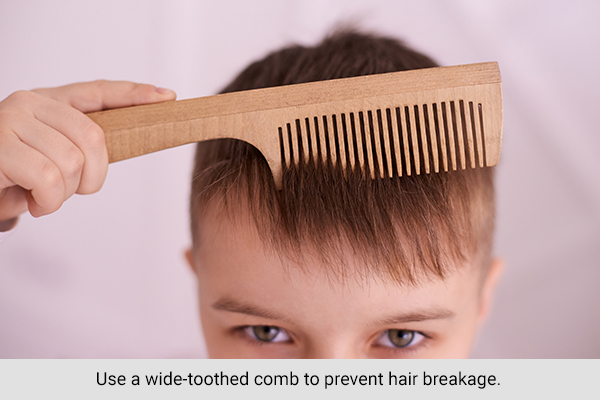
Here are a few preventive measures you can take to reduce hair breakage and damage:
- Do not tie your child’s hair too tight; tight braids or ponytails can strain the hair follicles.
- Do not use heat products such as blow-dryers or hair straighteners.
- Avoid dyeing or chemically treating your child’s hair.
- Make sure to shampoo your child’s hair after a swim.
- Use a wide-toothed comb to prevent hair breakage. (16)
When to See a Doctor
Scalp itching and irritation is a common occurrence in childhood and may not necessarily be a ringworm infection.
However, it is best to consult a doctor if you notice scabs or crusts on your child’s scalp, patches of hair loss, or any other symptoms of ringworm infection.
Final Word
Hair loss can be a complex situation with many different triggers that need to be identified for proper treatment. Hair loss in children is more often than not a sign of nutritional deficiencies. In some cases, a hormonal imbalance can be at play.
If your child’s condition does not improve even after trying the remedies given above, it may be time to consult a dermatologist for medical treatment. (1)
- Was this article helpful?
- YES, THANKS!NOT REALLY


